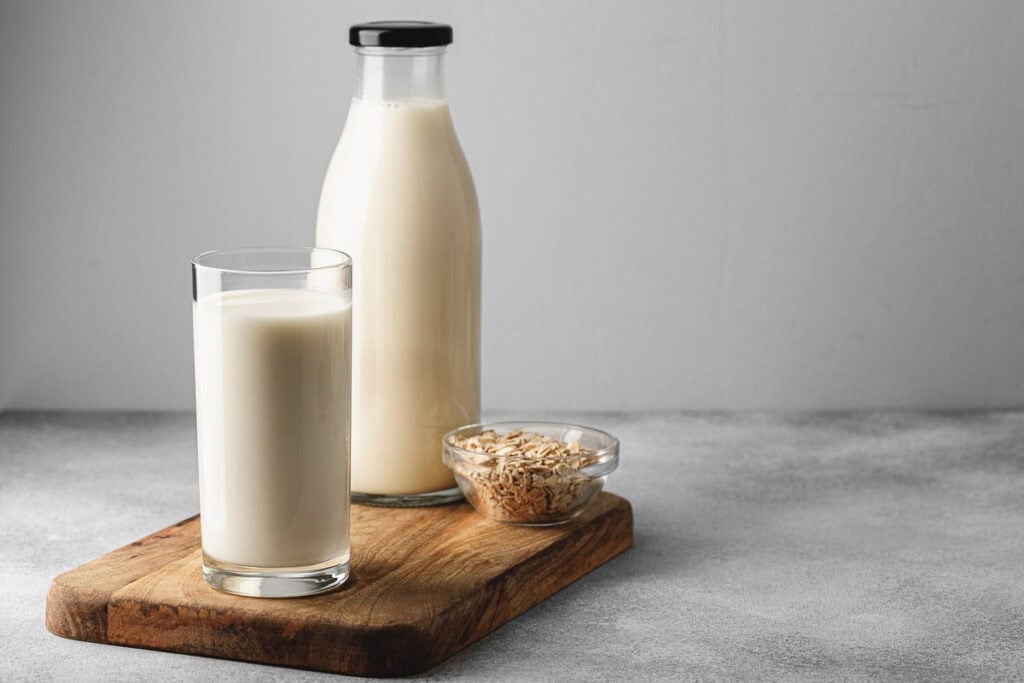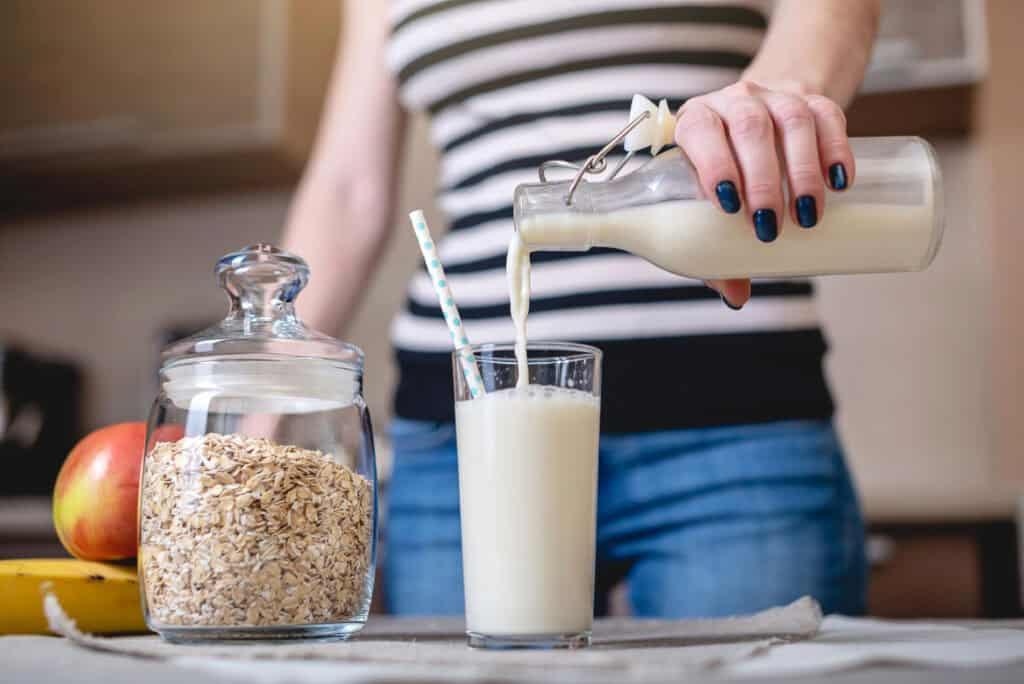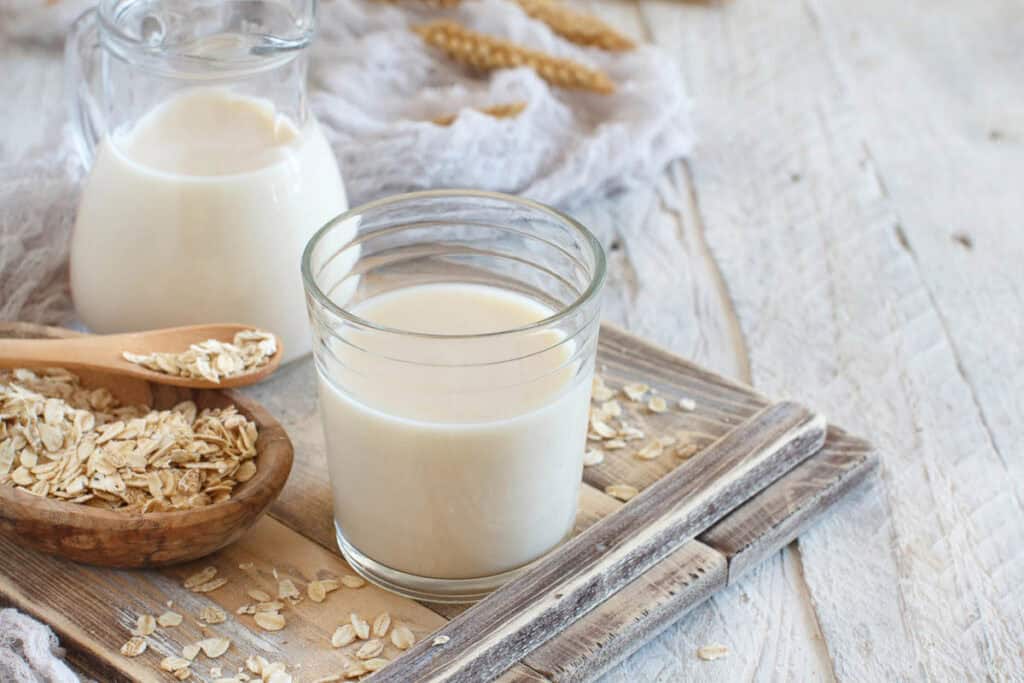Dairy-free milk options have been around for quite some time, with soy and almond milk paving the way for plant-based alternatives. However, oat milk brings a whole new angle to the scene with its remarkably creamy texture, surpassing most nut milks. Its ability to seamlessly blend into your favorite coffee beverage without compromising taste or consistency has made it a popular choice for non-dairy drinkers.

How oat milk is made
Oat milk is easy and simple to make at home, which we’ll cover in more depth below, but the commercial process is a bit more involved. Brands like Oatly, Califia, Planet Oat, Elmhurst and others produce oat milk by combining oats with water, then milling the mixture into a fine consistency. Enzymes are introduced to break down the oat starch, followed by the separation of bran solids, leaving behind a smooth, creamy liquid.
Some brands add oils like sunflower or canola to boost fat content and improve mouthfeel. Commercial oat milk may also include added sugars, flavors and nutrients, and it undergoes heat treatment for increased shelf life before packaging.
Homemade oat milk
Many prefer a homemade version due to its simplicity and the ability to control the ingredients. To make oat milk, blend 1 cup of rolled or steel-cut oats with 3 cups of cold water for 30 seconds in a powerful blender, then strain the mixture through a cheesecloth or nut milk bag.
Homemade oat milk allows for customization and tighter ingredient control compared to some store-bought options. Added ingredients like a pinch of salt,

The question everyone asks: Is oat milk healthy?
You’d think the answer to this question would be somewhat straightforward, but oat milk has sparked a lot of controversies when it comes to its nutrition. The best way to answer this hotly debated question is — it depends.
Oat milk nutrition
From a nutrition label standpoint, according to Healthline, oat milk has many benefits. One cup from most brands includes:
- 3g of protein
- 5g of fat
- 16g carbohydrates
- 2g fiber
- A variety of vitamins and minerals, including 50% of the daily value of vitamin B12.
Most store-bought brands are fortified with vitamins and minerals, so if you make your own oat milk, the percentages are likely to be lower. Nutrition also varies significantly by brand and whether or not you buy a sweetened or flavored option, which tends to add calories and carbohydrates.
Critics of oat milk argue that compared to cow, soy and almond milk, oat milk has less protein with more calories and carbohydrates. Another criticism oat milk is notorious for is the added preservatives and stabilizing agents. As Lara Clevenger, certified as an MSH, RDN and CPT, says, “Look at the ingredients, especially if you have a sensitive GI tract. Some oat milk has added gums and emulsifiers that can upset your stomach.” This is nothing new to dairy-free milk options, but one to be aware of as a customer.
Brands like Califia organic oat milk only contain three ingredients: oats, water and salt. Whereas the original Oatly — the brand best known for popularizing oat milk at the commercial level — has a much longer ingredient list that includes low erucic acid rapeseed oil, dipotassium phosphate, calcium carbonate, tricalcium phosphate, sea salt, dicalcium phosphate, riboflavin, vitamin A acetate, vitamin D2 and vitamin B12.

Why choose oat milk?
There are plenty of reasons to choose oat milk over other non-dairy options. For starters, it’s a great option for those who are lactose intolerant or steering clear of dairy for various reasons. It’s also an ideal choice for people with tree nut or soy allergies who want a versatile plant-based milk that can be used in everything from your morning cup of coffee to baking recipes or decadent homemade soups. Its richer, creamier texture makes it incomparable to other plant milks, where the biggest complaint is typically that they’re too thin or lack flavor.
“I love how creamy oat milk is compared to its other non-dairy counterparts. I love it in coffee. It also adds a touch of richness to desserts and casseroles.”
— Krystle, Baking Beauty
How to use oat milk
Of all the plant-based milks on the market today, oat milk reigns supreme as the most flexible. It’s perfect for your morning caffeine fix, whether that’s a traditional cup of coffee or a specialized latte, but its uses go far beyond a morning mug.
Because of the innate subtle sweetness of oats, oat milk lends itself well to many baking recipes where you’d normally use cow’s milk, like peanut butter and jelly muffins. Other uses for which it’s well-suited include smoothies, overnight oats and creamy soups. You can even make creamy, savory sauces or jazz up your favorite mashed potato recipe with oat milk.
The bottom line
For anyone avoiding dairy, soy or nuts, oat milk offers a fantastic alternative to other non-dairy options and cow’s milk. While its creamy, delicious experience is the main reason it’s enjoyed such a surge in popularity, keep in mind that it may lack some nutrients found in conventional milk, such as protein, calcium, vitamin B-12 and vitamin D. It’s also important to note that oat milk products can often include added preservatives and stabilizers that some may want to avoid.
Gina Matsoukas is the writer, photographer and recipe creator of Running to the Kitchen. Focusing on healthy, seasonal, whole-food recipes, her work has been featured in various online and print publications including Food Network, Prevention Magazine and Women’s Health. Gina lives in central New York, where she enjoys an active outdoor life.